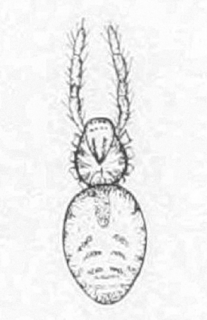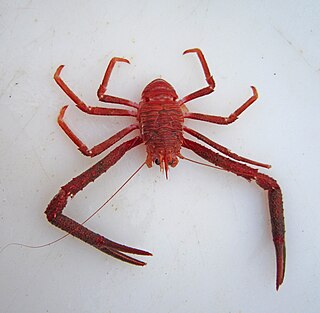
Squat lobsters are dorsoventrally flattened crustaceans with long tails held curled beneath the cephalothorax. They are found in the two superfamilies Galatheoidea and Chirostyloidea, which form part of the decapod infraorder Anomura, alongside groups including the hermit crabs and mole crabs. They are distributed worldwide in the oceans, and occur from near the surface to deep sea hydrothermal vents, with one species occupying caves above sea level. More than 900 species have been described, in around 60 genera. Some species form dense aggregations, either on the sea floor or in the water column, and a small number are commercially fished.

Gasteracantha cancriformis is a species of orb-weaver spider. It is widely distributed in the New World.

Munida is the largest genus of squat lobsters in the family Munididae, with over 240 species.

Parodia tenuicylindrica is a species of cactus from the genus Parodia. The small green cacti have yellow and red-brown spines, white wool and yellow flowers. They produce yellow-green fruit, and black seeds. P. tenuicylindrica can be found growing individually in Rio Grande do Sul, Brazil.

Parodia arnostiana is a species of cactus in the genus Parodia. The small, squat green plants produce yellow flowers, green fruit and black seeds. The species is found growing in Rio Grande do Sul, Brazil.

Munida rugosa, commonly known as the rugose squat lobster or plated lobster, is a species of decapod crustacean found in the north east Atlantic Ocean and the Mediterranean Sea.

The Munididae are a family of squat lobsters, taxonomically separated from the family Galatheidae in 2010.

Torbenella calvata is a species of squat lobsters in the family Munididae. The species name, calvata, comes from the Latin word calvatus, meaning made bare. This is in reference to its lack of spines on the anterior ridge of the second abdominal segment.
Munida abelloi is a species of squat lobster in the family Munididae. The species name is dedicated to Pere Abellô. It is found off of Kiribati and Futuna Island, at depths between about 105 and 400 metres.
Munida acacia is a species of squat lobster in the family Munididae. The species name is derived from the genus Acacia, referring to the spiny exterior margin of the propodi of the second and third pereopods. It is found near the western portion of Norfolk Ridge, at depths between about 510 and 560 metres.

Munida chydaea is a species of squat lobster in the family Munididae. The species name is derived from the Greek χυδαῖος, "abundant", in reference to how numerous the species is. The males measure between about 23.3 and 46.7 millimetres and the females between about 12.4 and 36.0 millimetres. It is found off of Tasmania and Victoria to Sydney, and in the Great Australian Bight, at depths between about 145 and 700 metres.

Dorymetaecus is a monotypic genus of Australian araneomorph spiders in the family Phrurolithidae, containing the single species, Dorymetaecus spinnipes. It was first described by William Joseph Rainbow in 1920, and has only been found on Lord Howe Island. Rainbow died in November 1919, shortly before publication of the work this species is described in.
Munida aequalis is a species of squat lobster in the family Munididae. The species name is derived from the Latin aequalis, meaning "like" or "same", referring to the similar size of the terminal spines of the basal antennular segment. It is found northwest of Tweed Heads, New South Wales to near Wooli, New South Wales, at depths between about 150 and 550 metres. The males are usually between 14.0 and 41.5 millimetres long, with the females being between about 19.1 and 28.5 millimetres long.
Munida acola is a species of squat lobster in the family Munididae. The species name is derived from the Greek akolos, meaning "bit", referring to its small size. It is found off of the Loyalty Islands, at depths between about 4 and 30 metres. The males are usually between 3.0 and 4.1 millimetres long, with the females being between about 2.8 and 3.1 millimetres long.
Munida affinis is a species of squat lobster in the family Munididae. It is found off of Cuba, at depths between about 360 and 550 metres.
Munida africana is a species of squat lobster in the family Munididae. The specific epithet refers to its distribution off Africa, where it was first found at depths of about 865 metres (2,840 ft). The males are generally around 9.5 millimetres (0.37 in) in size.
Munida agave is a species of squat lobster in the family Munididae. The specific epithet is derived from the name of one of Greek nereids, Agave. The males usually measure between 4.9 and 12.7 millimetres, with the females measuring between 3.7 and 9.7 millimetres. It is found off of Indonesia, the Philippines, Taiwan, and Japan, at depths between about 90 and 550 metres.
Munida albiapicula is a species of squat lobster in the family Munididae. The specific epithet is derived from the combination of the Latin albus, meaning "white", and apiculus, meaning "tip", referring to the white tips of the supraocular spines. The males usually measure up to 20.7 millimetres (0.81 in), with the females measuring up to 16.9 millimetres (0.67 in). It is found off of the north east coast of Taiwan, at depths between about 50 and 450 metres.
Munida alia is a species of squat lobster in the family Munididae. The specific epithet is derived from the Latin alius, meaning "another", in reference to the other species that are centered around M. heteracantha. M. alia is found off of central Queensland, at depths between about 490 and 510 metres.

Munida quadrispina is a species of squat lobster. It was originally described to science by James E. Benedict in 1902. This and other species of squat lobsters are sometimes referred to as "pinch bugs".











